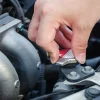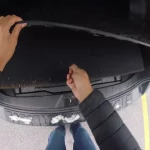If you own a motorcycle, then you know how essential your tires are to your riding experience. Whether you’re cruising on the highway or hitting the twisties, you need reliable and safe tires to get the most out of your bike. But when do you know it’s time to replace them? Tires are an essential component of a motorcycle, and knowing when to replace them is crucial.
Like any other part of your two-wheeler, they are subject to wear and tear, with the treads being the first to go. Knowing when to replace your tires can prevent fatalities, accidents, and serious damage to your motorcycle. So, how do you know when it’s time to swap them out? In this blog, we’ll provide you with valuable insights and clear guidelines to determine when you need to replace your motorcycle tire.
We’ll also give you tips on how to maintain your tires to make them last longer and provide a smooth riding experience, especially during the summer season when we tend to ride more. So, sit back, relax, and let’s get started!
Table of Contents
The Importance of Proper Tire Maintenance
Knowing when to replace your motorcycle tire is critical for your safety while riding. It’s recommended that you replace tires every five years, regardless of the amount of tread left. However, there are some signs to look for that may indicate the need for replacement sooner.
One of the most obvious signs is low tread depth, which can negatively affect your motorcycle’s handling and effectiveness during wet conditions. Other signs of a tire that needs replacement include cracking, bulging, or punctures. It’s essential to inspect your tires regularly for these signs and to replace them promptly to keep yourself safe while riding.
Proper tire maintenance, such as keeping them properly inflated and correctly balanced, can help prolong the life of your tires and keep you safe on the road. Remember, your motorcycle’s tires are the only parts in contact with the ground, so maintaining them properly is crucial to your safety.
Checking Your Tread Depth
Maintaining your vehicle’s tires is crucial for safe driving, and checking your tread depth is a big part of that. The tread on your tires provides traction and helps prevent your vehicle from slipping or sliding on the road. As your tires wear down, your ability to stop quickly or change direction decreases, which could be dangerous in certain road conditions.
To properly check your tire tread, try the penny test. Simply place a penny upside down between the tread ribs on your tire. If you can see all of Lincoln’s head, then your tires are worn down and need to be replaced.
It’s important to note that tire tread depth requirements vary by state, so be sure to check your local guidelines. By regularly checking your tire tread depth, you can ensure that your vehicle is safe to drive and avoid any potential accidents on the road.

Inspecting for Damage
Proper tire maintenance is an essential part of being a responsible vehicle owner. One aspect of tire maintenance that shouldn’t be overlooked is inspecting for damage regularly. This can help you identify issues early on before they become more significant problems.
Look for any cuts, punctures, or bulges on the tire surface, and if you notice anything out of the ordinary, take your vehicle to a mechanic for a closer look. Even small issues like a nail in the tire can be dangerous if left unattended, as they can lead to a blowout while driving. By taking a few minutes to inspect your tires regularly, you can prevent larger problems down the road and ensure the safety of yourself and your passengers.
Remember, your tires are the only point of contact between your vehicle and the road. Taking care of them properly is vital, so don’t neglect this critical aspect of vehicle maintenance.
Considering Age and Mileage
Proper tire maintenance is crucial when it comes to ensuring safety while driving. Age and mileage are two important factors to consider when it comes to your tires. The age of your tires can play a significant role in their performance and safety.
Over time, the rubber in your tires can break down and become less effective, making it important to replace your tires when they reach a certain age. Additionally, the mileage of your tires can also affect their performance and safety. As your tires accumulate miles, their treads can wear down, reducing their ability to grip the road and increasing the risk of hydroplaning.
Regularly inspecting your tires for signs of wear and tear, checking their air pressure, and rotating them can all help extend their lifespan and keep you safe on the road. Remember, maintaining your tires is an investment in your safety.
Signs That It’s Time to Replace Your Tire
As a motorcycle rider, knowing when to replace your tire is crucial for your safety and for the lifespan of your motorcycle. One of the most common signs that it’s time to replace your tire is wear and tear on the tread. The tread depth is essential for maintaining traction and stability, so if your tire’s tread is worn down to the wear bars, it’s time for a replacement.
Additionally, another sign that it’s time to replace your motorcycle tire is if you notice any deformations or bulges in the tire. Such deformations could indicate damage to the internal structure of the tire, which could lead to potential blowouts while riding. Furthermore, if you feel vibrations in your handlebars or the motorcycle when riding, it could indicate that your tire is unbalanced or has flat spots, and this can affect the handling of your bike, making it harder to control.
Keeping a close eye on your tires is critical for maintaining your safety and that of other riders, so if you notice any of these signs, consider replacing your tire.
Worn Tread
“Worn Tread” Have you taken a close look at your tires lately? It’s important to keep an eye on the tread on your tires, as worn-out tread can cause safety hazards on the road. The tread on your tires is what provides traction and helps your vehicle grip the road, especially in wet or slippery conditions. Signs of worn-out tread include shallow grooves, uneven wear, and bald spots.
You can also do a simple “penny test” to check your tire tread – just insert a penny into the groove with Lincoln’s head facing down. If you can see all of Lincoln’s head, it’s time to replace your tires. Don’t wait until it’s too late – replace your tires as soon as you notice signs of worn tread to ensure a safe driving experience.
Bulges or Blisters on the Sidewall
Bulges or Blisters on the Sidewall When it comes to tires, safety should always be a top priority. One telltale sign that your tire is no longer safe to use is the appearance of bulges or blisters on the sidewall. This can be caused by a number of factors, including overinflation or hitting a curb or pothole.
If you notice these abnormalities on your tire, it’s important to have it checked by a professional mechanic and possibly replaced before it leads to a blowout or other dangerous situation on the road. Don’t take any chances when it comes to your safety and the safety of others on the road. Keep an eye out for any signs of damage on your tires and act quickly to address them.
Remember, it’s better to be safe than sorry!
Loss of Air Pressure
Losing air pressure in your vehicle’s tires can be a frustrating experience, and it’s important to know the signs of when it’s time to replace them. One of the most obvious signs is if you notice that your tire feels soft or spongy when you press on it, as this indicates that it’s losing air pressure. Another sign to look for is if you notice your tire pressure monitoring system (TPMS) light come on, which means that one or more of your tires is underinflated.
Additionally, if you notice that your car is pulling to one side or you hear a thumping or pounding noise while driving, it could mean that your tire is going flat. If you’re experiencing any of these signs, it’s crucial to have your tires checked as soon as possible and have them replaced if necessary. Driving on underinflated tires can cause unsafe driving conditions and increase the risk of accidents.
So, make sure to keep an eye on your tire pressure and replace them when needed to stay safe on the road.
Tips for Choosing a New Tire
As a motorcycle rider, it’s essential to keep a close eye on the condition of your tires. Knowing when to replace motorcycle tire is important for your safety on the road. One of the most significant signs it’s time to replace your tires is if you notice cracks or cuts on the sidewalls or tread.
You should also check the tread depth regularly, and if it’s worn down to 2mm or less, it’s time to get new tires. Another important factor to consider is the age of your tires, even if they look visually fine, tires that are over five years old should be replaced. It’s also important to make sure you choose the right tire for your bike, considering factors like the type of riding you do, the kind of weather you typically ride in, and your budget.
Remember, keeping your tires in tip-top condition is crucial for your safety, so it’s worth investing time and money into finding the right set of tires for your motorcycle.
Matching the Tire to Your Bike
Choosing the right tire for your bike is crucial for both your safety and riding experience. When shopping for new tires, it’s important to match the tire to your bike’s make and model. This ensures the tire’s size, weight capacity, and tread pattern are appropriate for your specific bike and riding needs.
It’s also important to consider the type of riding you’ll be doing. For example, if you frequently ride on rough terrain, a tire with more aggressive tread would be best. On the other hand, if you mainly ride on smooth pavement, a road tire with minimal tread would be more suitable.
Don’t forget to also consider your climate and the weather conditions you’ll be riding in. If you live in an area with heavy rainfall, a tire with good wet traction is essential. By taking these factors into consideration, you can ensure you’re getting a tire that will provide optimal performance and safety for your bike.
Considering Your Riding Style and Conditions
When it comes to choosing the right tire for your riding style and conditions, there are a few key things to keep in mind. First and foremost, consider the terrain you’ll be riding on. If you’re mostly on-road, you’ll want a tire with a smooth tread pattern for maximum grip and control.
Off-road riders, on the other hand, will want a tire with a more aggressive tread pattern to ensure traction on loose and uneven surfaces. Additionally, think about your riding style. If you’re an aggressive rider who loves speed, look for tires with a stiffer construction to handle high speeds and hard cornering.
If you’re more of a casual rider who just wants to cruise, a softer tire with more flexibility may be a better fit. Ultimately, the goal is to find a tire that matches your needs and preferences, so be sure to do your research and consult with a professional if you’re unsure.
Conclusion
So, when do you know it’s time to replace your motorcycle tire? It’s simple – when the tread wears down to the point where you’re skating around corners like a figure skater on ice. Or, if you want to get scientific about it, consult the wear indicators on your tire. But let’s be real, a little slide action never hurt anyone, right? Just kidding, stay safe out there and replace those tires when it’s time!”
FAQs
What is the recommended lifespan of a motorcycle tire?
The recommended lifespan of a motorcycle tire is around 5 years, regardless of mileage.
How can I tell if it’s time to replace my motorcycle tire?
You can check the tire’s tread depth, look for cracks or bulges in the sidewall, and monitor for uneven wear or vibration when riding.
Can I replace just one motorcycle tire or do I need to replace them both at the same time?
It’s recommended to replace both tires at the same time for optimal performance, but if only one tire needs to be replaced, it’s possible to do so.
How often should I check the condition of my motorcycle tires?
You should check the condition of your motorcycle tires before every ride or at least once a week if your bike is sitting for an extended period of time.
Can I use car tires on my motorcycle if they are the same size?
It’s not recommended to use car tires on a motorcycle even if they are the same size, as they don’t have the proper construction for motorcycle use.
What are the consequences of riding on worn-out motorcycle tires?
Worn-out motorcycle tires can result in loss of traction, poor handling, decreased braking ability, and increased risk of accidents.
How can I extend the life of my motorcycle tires?
You can extend the life of your motorcycle tires by properly maintaining tire pressure, avoiding hard braking and accelerating, and storing the bike in a cool, dry place.



